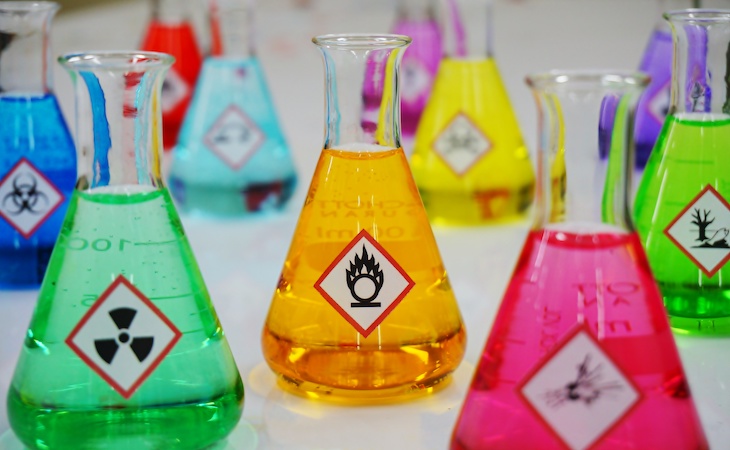Whether you load up a scary movie on Netflix or pay a visit to a haunted house, there are frights aplenty to be had this time of year. We’ve gotten into the Halloween spirit here at Saatva, which is why we’re shedding light on a totally spooky topic today: the chemicals that may be lurking in your mattress.
As American consumers have become savvier and more health-conscious, it’s only natural that we’d pay increasing attention to with what we put in, on, or near our bodies. That’s especially true for the items we use all the time—like the beds we sleep in every night. In fact, more and more people are concerned about mattress chemicals and the effect they may have on our (and the planet’s) well-being.
Following is a rundown of common mattress chemicals, how to choose a mattress that won’t harm your health, and what we do at Saatva to ensure our mattresses meet the highest standards for health and safety.
The lowdown on mattress chemicals
When it comes to mattresses, toxic ingredients are most likely to turn up in foams, padding, and fabrics that are treated with fire retardants, such as covers. These are the ones to watch out for:
Petroleum-based chemicals: Polyurethane foam, the type used in many mattresses and other household upholstery, is derived from petroleum. Conventional polyurethane foam can off-gas—the term for what happens when volatile organic compounds, or VOCs, escape from the foam into the air. Off-gassing is responsible for that unpleasant “new mattress” smell and can also cause irritation in people with chemical sensitivities or respiratory conditions like asthma. The most common petrochemicals are ethylene, propylene, butadiene, benzene, toluene, and xylene.
Chemical fire retardants: In 2007, the U.S. Consumer Product Safety Commission (CPSC) issued new federal guidelines to ensure that mattresses are able to withstand the required 30 minutes of exposure to an open flame. Mattress companies often use chemical treatments to meet these standards.
Not all chemicals used as flame retardants are a cause for concern, but there are a few that are: halogenated flame retardants (a.k.a. organohalogen flame retardants), which contain chlorine or bromine bonded to carbon, and organophosphorous flame retardants, which contain phosphorus bonded to carbon. In a peer-reviewed research paper, the Green Science Policy Institute found that these chemicals tend to build up in the body and are associated with endocrine disruption, immunotoxicity, and negative effects on child development.
Unfortunately, as the Center for Environmental Health (CEH) notes, manufacturers are not required to disclose what chemical flame retardants they use. One way to take some of the guessing out of things is by buying an American-made mattress. Mattresses made in the United States are subject to strict safety regulations that prohibit the use of harmful or toxic chemicals in the production process. Foams of unknown origin may not be subject to the same health and safety standards.
PBDEs: Polybrominated diphenyl ethers (PBDEs) are another class of chemical flame retardants—but they’ve been banned in the United States since 2005. According to the U.S. Environmental Protection Agency, PBDEs have been linked to thyroid disruption and neuro-developmental toxicity in rats and mice. The EPA also notes that traces of PBDEs have been found in human tissue, blood, and breast milk.
So should you ditch that pre-2005 mattress? As a report in Mother Jones points out, there is no conclusive evidence linking mattress chemicals to health risks, largely because tracking the long-term effects of these chemicals is next to impossible. That being said, if you’re still sleeping on a foam mattress that was purchased before PBDEs were banned, and it has a ripped cover or foam that’s misshapen or breaking down, the Washington State Department of Health advises replacing it.
How to avoid mattress chemicals
If you’re concerned about mattress chemicals, choosing a mattress with organic components (or, if your budget permits, a fully organic mattress) is the surest way to avoid them. In addition to lowering your exposure to potentially hazardous chemicals, organic ingredients also have fewer allergens. Here’s what to look for:
Wool: Wool is often used as a natural flame retardant. It’s also antibacterial and antimicrobial, resistant to dust mites, and hypoallergenic. Not only is wool better for the environment and your health than chemical fire barriers, but it’s also gentler on your skin.
Organic cotton: Like wool, organic cotton is also hypoallergenic. Plus, organic cotton is grown without the use of chemical insecticides or synthetic fertilizers, so it doesn’t contaminate water systems with chemical runoff. Organic cotton is typically used for mattress covers since it’s soft and breathable, making it ideal for temperature control.
Greener foams: Conventional polyurethane foams can off-gas. As an alternative, look for foams that contain plant-based ingredients, such as soybean oil, in place of some of the petroleum derivatives. Greener foams are also lower in VOCs and free of formaldehyde or heavy metals. Such foams often carry third-party certifications, like CertiPUR-US®1, Oeko-Tex, and Greenguard.
Natural latex: Latex is a natural material, made from the sap of the rubber tree. Natural latex is hypoallergenic, biodegradable, and does not off-gas. (Learn about the differences between memory foam mattresses and latex mattresses.) Not all latex is natural, however. There is such a thing as a synthetic latex mattress, and this type of mattress is made from petroleum-based ingredients.
How Saatva keeps chemicals out of mattresses
At Saatva, we take health and safety seriously. Saatva mattresses use recycled tempered steel, eco-friendly foams (we replace 30% of our foams with natural ingredients derived from soybean and corn oil), and organic cotton coverings.
The memory foam in Saatva’s

Our ultra-premium 5-lb memory foam mattress for a body-hugging feel
is certified by CertiPUR-US®, meaning it has met rigorous standards for performance and is guaranteed to be low-VOC and free of toxic chemical. Saatva’s latex

Our dual-sided organic natural latex mattress for buoyant, pressure-relieving comfort
is made from natural latex. Saatva also uses a natural thistle barrier made mainly from wood pulp as a flame retardant. No chemical sprays are applied to any of our mattresses. Plus, Saatva foams are shipped stable—that means that any off-gassing that occurs happens before the mattress ever gets to your home.
Related reads:
- CertiPUR-US® is a registered trademark of the Alliance for Flexible Polyurethane Foam, Inc. ↩︎









